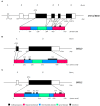Bardet-Biedl Syndrome as a Chaperonopathy: Dissecting the Major Role of Chaperonin-Like BBS Proteins (BBS6-BBS10-BBS12)
- PMID: 28824921
- PMCID: PMC5534436
- DOI: 10.3389/fmolb.2017.00055
Bardet-Biedl Syndrome as a Chaperonopathy: Dissecting the Major Role of Chaperonin-Like BBS Proteins (BBS6-BBS10-BBS12)
Abstract
Bardet-Biedl syndrome (BBS) is a rare genetic disorder that belongs to the group of ciliopathies, defined as diseases caused by defects in cilia structure and/or function. The six diagnostic features considered for this syndrome include retinal dystrophy, obesity, polydactyly, cognitive impairment and renal and urogenital anomalies. Furthermore, three of the 21 genes currently known to be involved in BBS encode chaperonin-like proteins (MKKS/BBS6, BBS10, and BBS12), so BBS can be also considered a member of the growing group of chaperonopathies. Remarkably, up to 50% of clinically-diagnosed BBS families can harbor disease-causing variants in these three genes, which highlights the importance of chaperone defects as pathogenic factors even for genetically heterogeneous syndromes such as BBS. In addition, it is interesting to note that BBS families with deleterious variants in MKKS/BBS6, BBS10 or BBS12 genes generally display more severe phenotypes than families with changes in other BBS genes. The chaperonin-like BBS proteins have structural homology to the CCT family of group II chaperonins, although they are believed to conserve neither the ATP-dependent folding activity of canonical CCT chaperonins nor the ability to form CCT-like oligomeric complexes. Thus, they play an important role in the initial steps of assembly of the BBSome, which is a multiprotein complex essential for mediating the ciliary trafficking activity. In this review, we present a comprehensive review of those genetic, functional and evolutionary aspects concerning chaperonin-like BBS proteins, trying to provide a new perspective that expands the classical conception of BBS only from a ciliary point of view.
Keywords: BBS10; BBS12; Bardet-Biedl syndrome; MKKS/BBS6; chaperonin-like BBS proteins; chaperonopathies; ciliopathies.
Figures

Similar articles
-
BBS6, BBS10, and BBS12 form a complex with CCT/TRiC family chaperonins and mediate BBSome assembly.Proc Natl Acad Sci U S A. 2010 Jan 26;107(4):1488-93. doi: 10.1073/pnas.0910268107. Epub 2010 Jan 4. Proc Natl Acad Sci U S A. 2010. PMID: 20080638 Free PMC article.
-
Bardet-Biedl syndrome: The pleiotropic role of the chaperonin-like BBS6, 10, and 12 proteins.Am J Med Genet C Semin Med Genet. 2022 Mar;190(1):9-19. doi: 10.1002/ajmg.c.31970. Epub 2022 Apr 4. Am J Med Genet C Semin Med Genet. 2022. PMID: 35373910 Free PMC article. Review.
-
Mutations in chaperonin-like BBS genes are a major contributor to disease development in a multiethnic Bardet-Biedl syndrome patient population.J Med Genet. 2010 Jul;47(7):453-63. doi: 10.1136/jmg.2009.073205. Epub 2010 May 14. J Med Genet. 2010. PMID: 20472660
-
Identification of a novel BBS gene (BBS12) highlights the major role of a vertebrate-specific branch of chaperonin-related proteins in Bardet-Biedl syndrome.Am J Hum Genet. 2007 Jan;80(1):1-11. doi: 10.1086/510256. Epub 2006 Nov 15. Am J Hum Genet. 2007. PMID: 17160889 Free PMC article.
-
Bardet-Biedl Syndrome Overview.2003 Jul 14 [updated 2023 Mar 23]. In: Adam MP, Feldman J, Mirzaa GM, Pagon RA, Wallace SE, Amemiya A, editors. GeneReviews® [Internet]. Seattle (WA): University of Washington, Seattle; 1993–2025. 2003 Jul 14 [updated 2023 Mar 23]. In: Adam MP, Feldman J, Mirzaa GM, Pagon RA, Wallace SE, Amemiya A, editors. GeneReviews® [Internet]. Seattle (WA): University of Washington, Seattle; 1993–2025. PMID: 20301537 Free Books & Documents. Review.
Cited by
-
A case of Bardet-Biedl syndrome caused by a recurrent variant in BBS12: A case report.Biomed Rep. 2021 Dec;15(6):103. doi: 10.3892/br.2021.1479. Epub 2021 Oct 21. Biomed Rep. 2021. PMID: 34760276 Free PMC article.
-
Ciliopathies in pediatric endocrinology.Ann Pediatr Endocrinol Metab. 2023 Mar;28(1):5-9. doi: 10.6065/apem.2244288.144. Epub 2023 Mar 31. Ann Pediatr Endocrinol Metab. 2023. PMID: 37015775 Free PMC article.
-
Next-Generation Sequencing in the Diagnosis of Patients with Bardet-Biedl Syndrome-New Variants and Relationship with Hyperglycemia and Insulin Resistance.Genes (Basel). 2020 Oct 29;11(11):1283. doi: 10.3390/genes11111283. Genes (Basel). 2020. PMID: 33138063 Free PMC article.
-
Exome sequencing in a Romanian Bardet-Biedl syndrome cohort revealed an overabundance of causal BBS12 variants.Am J Med Genet A. 2023 Sep;191(9):2376-2391. doi: 10.1002/ajmg.a.63322. Epub 2023 Jun 9. Am J Med Genet A. 2023. PMID: 37293956 Free PMC article.
-
Proteome and metabolomic profile of Mongolian horse follicular fluid during follicle development.Sci Rep. 2024 Aug 26;14(1):19788. doi: 10.1038/s41598-024-66686-7. Sci Rep. 2024. PMID: 39187528 Free PMC article.
References
-
- Beales P. L., Katsanis N., Lewis R. A., Ansley S. J., Elcioglu N., Raza J., et al. . (2001). Genetic and mutational analyses of a large multiethnic Bardet-Biedl cohort reveal a minor involvement of BBS6 and delineate the critical intervals of other loci. Am. J. Hum. Genet. 68, 606–616. 10.1086/318794 - DOI - PMC - PubMed
-
- Billingsley G., Bin J., Fieggen K. J., Duncan J. L., Gerth C., Ogata K., et al. . (2010). Mutations in chaperonin-like BBS genes are a major contributor to disease development in a multiethnic Bardet-Biedl syndrome patient population. J. Med. Genet. 47, 453–463. 10.1136/jmg.2009.073205 - DOI - PubMed
Publication types
LinkOut - more resources
Full Text Sources
Other Literature Sources

